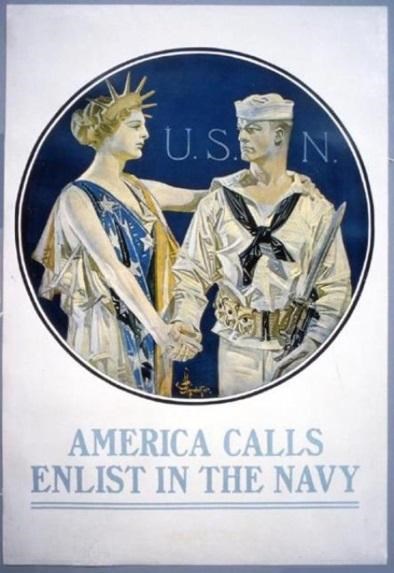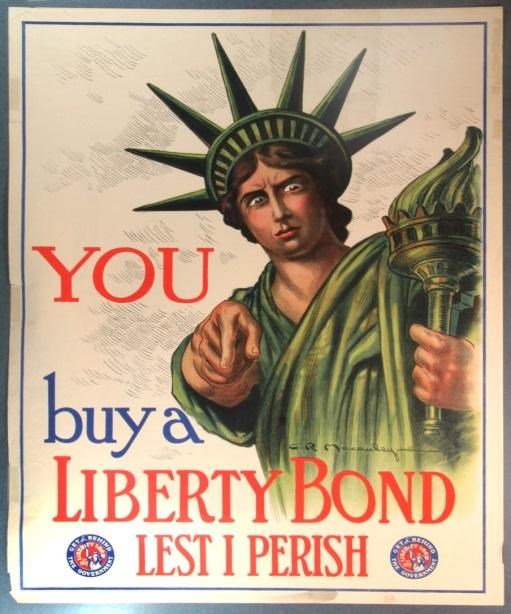Last updated: August 2, 2023
Article
The Statue of Liberty in Recruitment and War Bonds Posters

NPS Collections
The silhouette of the Statue of Liberty, torch shining brightly against a golden sky in the Smith and Porter lithograph poster issued by the Boston Committee of Public Safety in 1917 intended to stir dual feeling of patriotrism and fear. Such feelings, it was believed would then motivate enlistment to the Navy “For Liberty’s Sake.”

NPS Collections
This 1917 Navy enlistment poster was designed by the popular artist and advertising illustrator Joseph Christian Leyendecker. The Leyendecker’s color lithograph has a determined looking young sailor armed with bayonet rifle and ammunition accompanied by the human embodiment of liberty. The allegorical figure wears the Statue of Liberty’s crown and, draped in the United States flag, is encouraging the sailor as “America Calls.”
Raising taxes, borrowing and printing money were the government’s primary means to fund the war. William Gibbs McAdoo, Secretary of the Treasury, was opposed to printing money since this would lead to inflation and recognized the burden of ever increasing taxes on the American public. To meet the funding need, he chose a mixture of raising taxes, to reduce consumerism leaving industry to produce war equipment and the sale of war bonds and loans, borrowing money from the public with interest.

NPS Collections
McAdoo initiated the Liberty Bonds plan with the sale of war bonds coordinated and managed by the member banks of the Federal Reserve System. The plan’s goal was to educate the public about the war’s objectives and explain the role of war bonds with an understanding about the financial workings of the United States in time of war. To entice the public to purchase bonds the Liberty Bond campaign was initiated and conducted by the Committee on Public Information headed by George Creel. The Committee employed the massive use of advertising posters, handbills and fliers presented to the public by way of billboards, volunteer distributors, inserted cards in department store catalogs and library books, and celebrity personalities holding rallies and shows for thousands people.
An example of the intensity of the campaign is in artist Charles Raymond Macauley’s impressive 1917 poster, “You , Buy A Liberty Bond / Lest I Perish.” The poster has a stern, eyes glaring Statue of Liberty looking at and pointing directly to the viewer in a posture of ordering the purchase of bonds. The image is designed to strike fear in the viewer, since failure to buy bonds and do as ordered would lead ultimately to the complete destruction of the American freedom as symbolized by the Statue of Liberty.

NPS Collections
